ISSN ONLINE(2278-8875) PRINT (2320-3765)
ISSN ONLINE(2278-8875) PRINT (2320-3765)
P.Ranjitha1, V.Dhinesh2, Dr.M.Muruganandam3
|
| Related article at Pubmed, Scholar Google |
Visit for more related articles at International Journal of Advanced Research in Electrical, Electronics and Instrumentation Engineering
This paper presents a soft switching technique used along with the series connected transformer to run a PMDC motor. The three level PWM circuits with two active switches and the capacitors are connected in parallel with it. The two switches are reduced in the existing method. Instead of those two switches two capacitors are used to reduce the switching losses. The series resonant converter is used to achieve ZVS turn-on for all power switches and zerocurrent switching for all rectifier diodes. The switching losses of the switches and the reverse recovery loss of the diodes are reduced. The resonant converter has wide range of switching frequency that can be overcome by adopting the PWM method to regulate the output voltage. The series connected transformer is used in the primary and secondary side to balance and share the current which is supplied to the load. The PMDC motor can be used as load. The conventional method does not use any controller to control the resistive load. The speed of the motor can be sensed by using the fuzzy logic controller.The leakage inductance can be reduced by making the frequency constant.
Keywords |
| ZVS, ZCS, Fuzzy logic controller, PMDC motor, Converter, Cascaded Transformer |
INTRODUCTION |
| In the conventional system three level or multilevel converters has been used obtaining high voltage. By using the neutral point diode and clamp, flying clamp the voltage stress can be reduced in the converters. Three level ZVS or ZCS converters [1] have been proposed to reduce the switching losses at the desired load range. To extend the range of the ZVS or ZCS the additional circuitry or leakage inductance has been used. The series resonant converters with variable switching frequency have been presented to have the advantages of high voltage gain and high circuit efficiency with a wide load range [2]. The series resonant converters have been widely adopted in the commercial computer and communication products [3].A resonant mode system gives the several benefits avoids many of the disadvantages occurred due to higher frequencies. While using a resonant circuit in the power path, the switches can be easily operate at either zero current or voltage in the waveform, So that the stress level of the switches can be reduced; the resonant sine waves reduces the higher frequency harmonics that minimises the noises and so the circuit now requires inductance and capacitance, parasitic elements may enhance the circuit performance. With these benefits, power systems operating in the range of 500 kHz to 2.0 MHz are now practical [4-6]. Even though the resonant converters has wide range of frequency from light load to full load the magnetic components in the series resonant converters are not easy to design at the optimal condition. so it is better that the dc–dc converter has the advantages of ZVS and ZCS functions in the series resonant converter and the constant switching frequency with duty cycle control. A new two level ZVS converter is presented for high input and current applications. The switches in the existing system are less than the conventional system [7-11]. The selected switching frequency is less than the series resonant frequency. Thus, power switches can be turned ON at ZVS and rectifier diodes can be turned OFF at ZCS within nearly entire load range. The switching loss of MOSFETs and the reverse recovery loss of diodes are reduced. The voltage stress of MOSFETs is clamped at one-half of input voltage due to the three-level circuit topology. The capacitors are used instead of the MOSFETs. So that the switching losses can be reduced. The primary and secondary of the transformer connected in series to balance the load current and the load can be changed as PMDC motor instead of the resistors connected in the proposed method. The PMDC motor is a dc motor which has stator and rotor with it. The PMDC motor has a permanent magnet as a rotor the other features are like a dc motor. The PWM level has been reduced in the existing system. Three-level PWM circuits with the same power switches are adopted for high output current applications [12-16]. |
| The main drawback of the conventional method is that to achieve ZVS is very difficult only the energy stored in the leakage inductance of the transformer can be used to achieve ZVS [17 & 18]. By adding external resonant inductance in series with the primary side of the transformer, it will cause duty cycle loss and increase the oscillations on the secondary side of the transformer. In order to solve the problems, the lagging switches can be replaced by adopting an insulated gate bipolar transistor (IGBT) instead of MOSFET. The ZVS, ZCS combination gives leading mechanism of the switches and thus the duty cycle can be increased by making the frequency as constant. The main objective of this paper is summarised as, |
| 1. To run the PMDC motor by using the series connected transformer with the help of soft switching technique. |
| 2. To reduce the leakage inductance by making the frequency constant and increasing the duty cycle. |
II.BLOCK DIAGRAM |
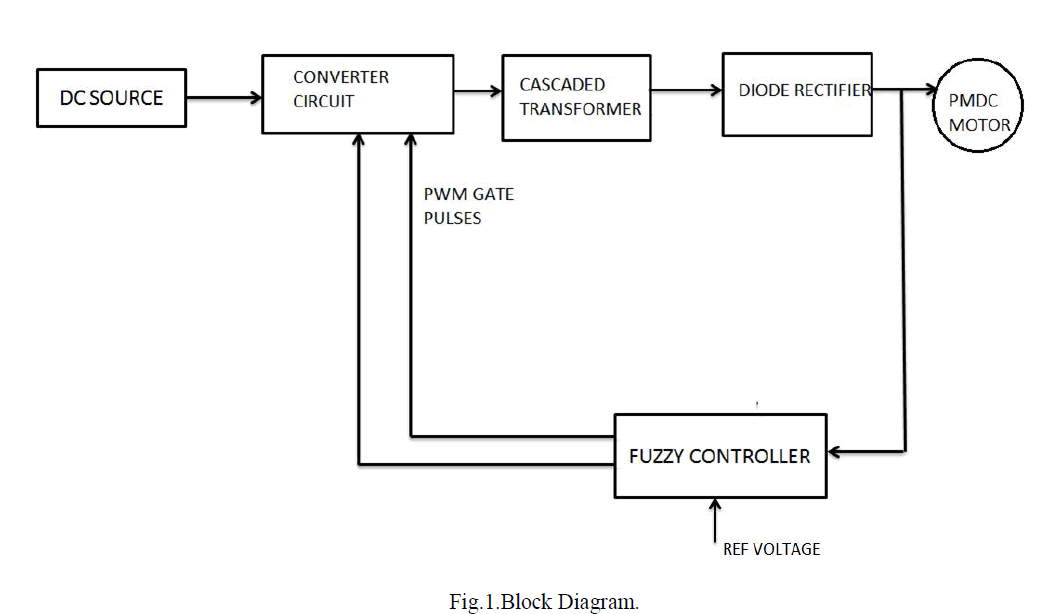 |
| In the above figure 1 the DC source is given to the converter. The converter converts the given dc voltage in to an ac voltage and it is fed to the transformer. The transformer step downs the voltage from 210V to 150 V. Then the step downed ac voltage is fed to a diode bridge rectifier where it is converted in to a dc voltage.Atlast the dc voltage is supplied to the PMDC motor. The voltage supplied to the fuzzy logic controller generates the PWM pulses so that it acts as a gate pulse to the converter [19 & 20]. Hence the speed of the PMDC motor is controlled by varying the PWM pulses. |
III.CIRCUIT CONFIGURATION |
| Cin1 and Cin2 are equal and large enough to share the input voltage vCin1 = vCin2 = Vin/2. S1, S2 are MOSFETs and the voltage stresses of S1, S2 are equal to Vin/2. C1, C2 are the capacitances used instead of MOSFETs S3, S4 respectively. Da and Db are the freewheeling diodes. Cf is a flying capacitor and its voltage is equal to Vin/2. Cr1 and Cr2 are the series resonant capacitances and the average capacitor volt- ages VCr1 = VCr2 = Vin/2. Lr1 and Lr2 are the series resonant inductances. Lm1−Lm4 are the magnetizing inductances of the transformers T1−T4, respectively. D1– D4 is the rectifier diodes. Co is the output filter capacitor and Ro is the load resistance. The proposed converter includes two three- level ZVS circuits with the same power switches and the flying capacitor.S1 and S4 are the leading switches, and S2 and S3 are the lagging switches. Based on the ON/OFF states of S1–S4, [1-6] three voltage levels Vin, Vin/2, and generated on the ac terminal voltages Vab and Vbc. The center tapped diode rectifier without the output filter inductor is used in the secondary side to obtain a stable output voltage Vo with one diode conduction loss. |
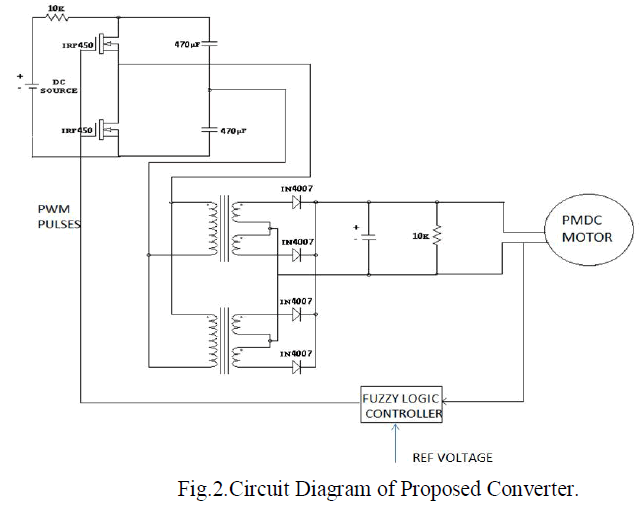 |
| In the proposed circuit diagram of figure 2 the switches S1, S2 can be used instead of using large number of MOSFETs the capacitors C1, C2 can be used to minimise the switching losses. The series transformers size are further reduced to reduce the size of magnetic cores and winding turns and to balance the primary and secondary side currents of two circuit cells with the interleaved connection of transformer secondary windings. The leakage inductance can also be reduced. |
| A resonant converter, like all switching regulators, requires an output filter to smooth the power delivered to the load. This output filter must have a break frequency less than one fifth the lowest switching frequencies. Therefore we assume the current through Lo and the voltage across Co are both essentially constant at the switching frequency Instead of resistance the PMDC motor has been used as load[17]. The voltage stress of each power semiconductor is clamped at Vin/2 and the current stresses of each transformer secondary winding and the rectifier diodes are equal to half load current |
IV.OPERATING MODES OF CONVERTERS |
MODE1: |
| In mode1only one switch and one capacitor is turned on the remaining switches should be turned off . The time period of switches from t0 to t1 i.e to <t<t1 the switch S1and the capacitor C2 is conducting S1 can be turned on with zero voltage and the transformers primary voltages are negative for first transformer and primary voltage of second transformer are positive the primary of transformer T1, T3 and T2, T4 can be coupled the magnetising current ilm1, ilm2 decreases linearly and the ilm3, ilm4 increases linearly output is given to the diode and it can be stored in the capacitor through the capacitor current supplied to the load is shown in figure 3 . |
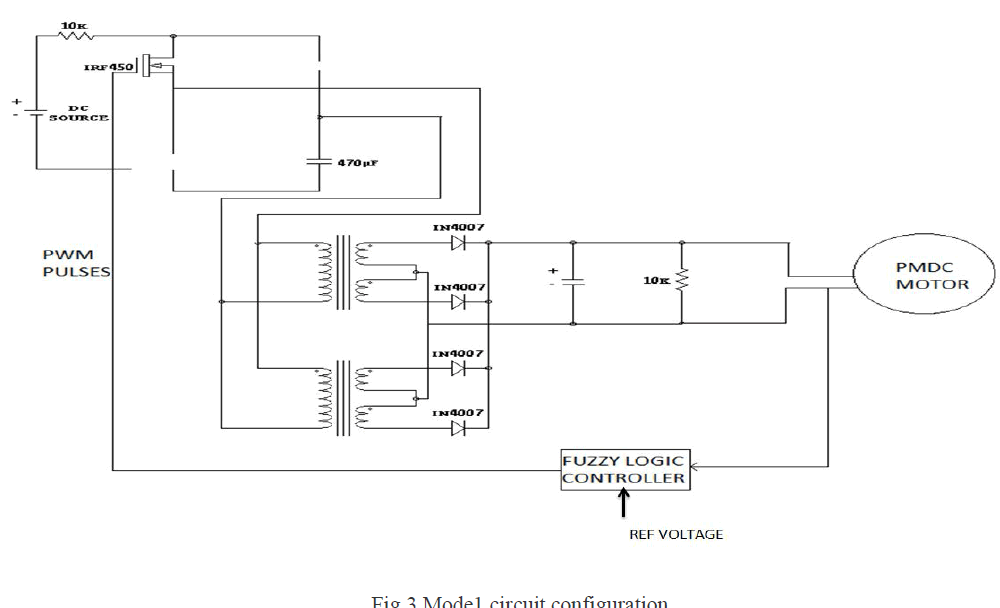 |
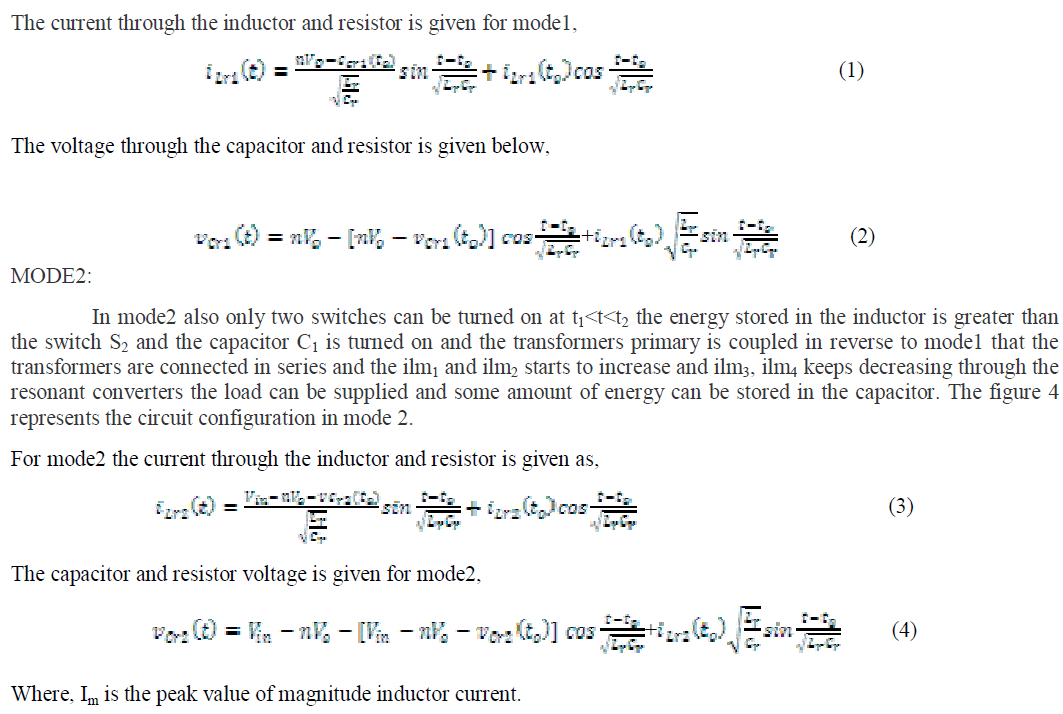 |
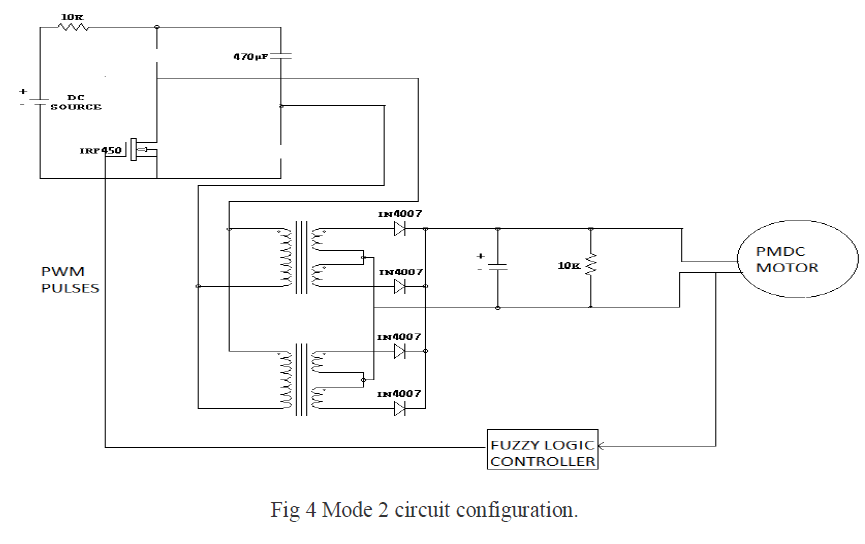 |
V. RESULT AND DISCUSSION |
| The DC supply is given to the switches, there are two switches used and two capacitors can be used to reduce the switching losses. The switches can be turned on and off alternatively. The soft switching technique of ZVS and ZCS can be implemented.The input waveform of the ZCS is shown in figure 5 and ZVS is shown in the figure 6. |
| The ZVS condition can be obtained when the PWM pulse is given to the switch the switch can be turned on at that time the voltages across the switch is zero. If the switches does not goes to the off state then the voltage remains in zero [6-9]. The ZCS condition can be obtained when the PWM pulse is given to the switches the switch is turned on and the current across the switch is full. Whenever the switch is turned on and off the current is full and goes to zero according to the switch position. The coupled inductor can be used as the transformer[18]. The supply is given through the switches it can be stepped down through the transformer and give it to the PMDC motor. The speed of the motor can be sensed through the fuzzy controller. The feedback from the motor is given to the hall sensor, it sense the speed and position of the motor. It gives signals to the controller and the controller controls the speed of the motor by controlling the pulse of the PWM[19-20]. The ZCS can be connected to the pulse generator and the current controller [11-13]. Both the ZCS and ZVS can be used to achieve the controlled output when the input is given to the series connected transformer. The output obtained from the PMDC motor is not a controlled output because the fuzzy controller can be used to control the voltage applied to the motor but in future the speed of the motor can be controlled. The output waveform is shown in figure 7. |
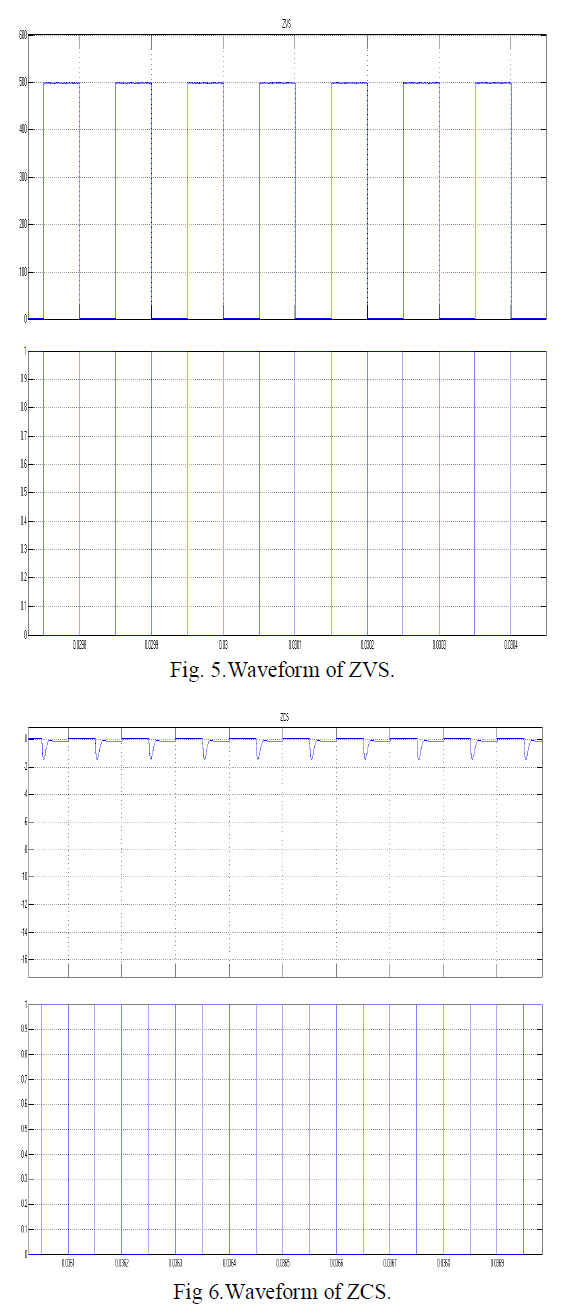 |
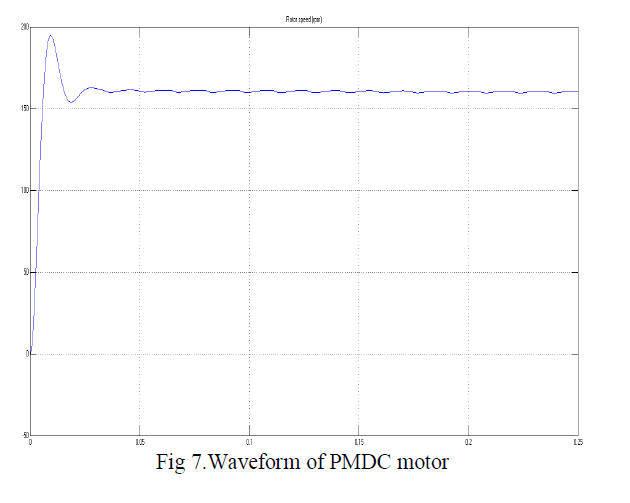 |
VI.CONCLUSION |
| A new PWM converter is presented to have the features of ZVS turn-on for all switches from 10% load to full load, ZCS for all rectifier diodes, low voltage stress of MOSFET, less switch counts, and low current stress of rectifier diodes. The PWM circuits sharing the same power switches are adopted to reduce the input ripple current and lessen the current stress of transformer windings and rectifier diodes. The center-tapped rectifiers are used at the secondary side to have only one diode conduction loss. Compared to the conventional parallel three-level PWM converter, the proposed converter can reduce two MOSFETs, two clamped diodes, one flying capacitor, and one PWM controller and instead of MOSFETS, IGBTS can be used as a switching components since it has the advantages of both MOSFET and BJT [1-6]. In order to balance output currents of the PWM circuits, the transformers are connected in series at the primary and secondary sides. The fixed switching frequency with duty cycle control instead of the variable switching frequency in the conventional series resonant converter is used to regulate the output voltage. Based on the series resonant behaviour (switching frequency is less than series resonant frequency), all switches are turned ON at ZVS and all rectifier diodes are turned OFF at ZCS. Thus, the switching losses on power semiconductors are reduced [11-15]. By making the frequency constant leakage impedance of the transformers can be reduced in conventional method the load used is resistive and none of the controller is used in that. The PMDC motor can be used as a load and the fuzzy controller technique is be used to control the voltage given to the load and also the speed can be sensed by the fuzzy controller. |
References |
|